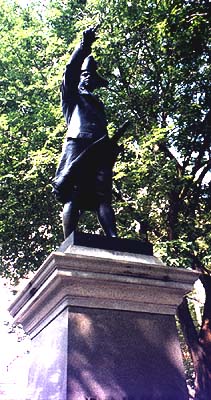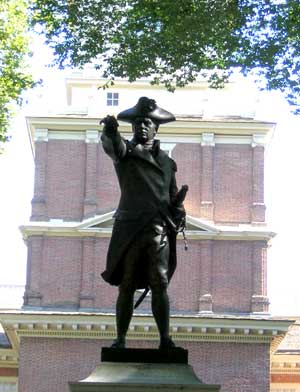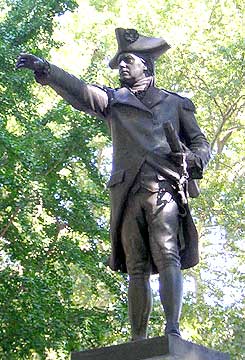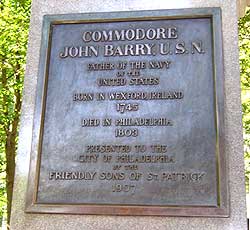Commodore Barry
(1745-1803)
"Father of the American Navy"
by John Barry Kelly

Statue of Commodore Barry standing in Independence Square, on the south side of Independence Hall
Few Americans are well-acquainted with the gallantry and heroic exploits of Philadelphia's Irish-born naval commander, Commodore John Barry. Obscured by his contemporary, naval commander John Paul Jones, Barry remains to this day an unsung hero of the young American Republic. As most naval historians note, Barry can be classed on a par with Jones for nautical skill and daring, but he exceeds him in the length of service (17 years) to his adopted country and his fidelity to the nurturing of a permanent American Navy. Indeed, Barry deserves the proud epithet, "Father of the American Navy," a title bestowed on him not by current generations of admirers, but by his contemporaries, who were in the best position to judge.
In the space of 58 years, this son of a poor Irish farmer rose from humble cabin boy to senior commander of the entire United States fleet. Intrepid In battle, he was humane to his men as well as adversaries and prisoners. Barry's war contributions are unparalleled: he was the first to capture a British war vessel on the high seas; he captured two British ships after being severely wounded in a ferocious sea battle; he quelled three mutinies; he fought on land at the Battles of Trenton and Princeton; he captured over 20 ships including an armed British schooner in the lower Delaware; he authored a Signal Book which established a set of signals used for effective communication between ships; and he fought the last naval battle of the American Revolution aboard the frigate Alliance in 1783.
Early Years
John Barry was born in a modest thatched cottage in 1745 at Ballysampson on Our Lady's Island, which is part of Tacumshin Parish in County Wexford, Ireland. Wexford, at the southeasternmost part of Ireland, has always had a strong maritime tradition. Yet Barry's father was a poor tenant farmer who was evicted by his British landlord. The family was forced to relocate to the village of Rosslare.
At Rosslare, the youth's uncle, Nicholas Barry, was captain of a fishing skiff, and the young man determined at an early age to follow his uncle to sea. Barry started out as a ship's cabin boy, and graduated from seaman to able seaman and ultimately, a Mate's rating. Barry grew to be a tall, muscular, well-respected seaman. A salient event which occurred in Barry's youth led to a lifelong enmity of oppression and the British. At a young age Barry learned of the massacre of some 3,000 Wexfordians under an invading force led by Oliver Cromwell in 1649.
His First Command

Barry's first command came in 1766 aboard the schooner, Barbadoes, sailing out of Philadelphia, which Barry adopted as his home port. Barry had good reason to make Philadelphia his new home. William Penn's legacy of religious freedom allowed Roman Catholics, which Barry was, greater latitude of worship than most anywhere else in the Colonies. Further, the city was emerging as a great maritime trade center. Its growing population, which exceeded 30,000 by the start of the Revolution, hungered for imported goods brought in by ships piloted by captains such as Barry. Plying back and forth between Philadelphia and the West Indies, Barry gained his early skills of command at the helm of several merchant ships.
In the West Indies trade, Barry honed his nautical skills making at least nine round trips without a single mishap. Philadelphians came to like "Big John" Barry due to his reliability, personable nature and his success in the merchant shipping business. His next command, the Patty and Polly, was a small brigantine which he took on but a single voyage. Shortly after, Barry took command of the Industry, a 45-ton vessel which he described as a "good schooner."
By 1772, Barry's abilities as a shipmaster had come to the attention of one of Philadelphia's premier mercantile houses, Meredith and Clymer. Reese Meredith recognized Barry's ability by assigning him command of the vessel Peg, quite a plum for a young captain. About the time colonial difficulties with the mother country necessitated the convening of the First Continental Congress in 1774, Barry began a lifelong friendship and collaboration with the Revolutionary financier, Robert Morris. Barry's last pre-revolutionary sailing experience came in the service of Morris, who was a partner in Philadelphia's top merchant shipping firm, Willing, Morris and Cadwalader. Barry was assigned to their sleek 200-ton ship, Black Prince. It was aboard Black Prince on a return voyage from England that Barry made the amazing and unparalleled record of travelling 237 miles by dead reckoning in a 24 hour period — the fastest day of sailing recorded in the 18th century.
The Private Barry
In private life, Barry's world was twice darkened by tragic events. First was the premature death of his first wife, Mary Clary (or Cleary), whom he had married at Philadelphia's Old St. Joseph's chapel on October 31, 1767. Mary's death on February 9, 1774, at 29 years of age, grieved him all the more since he was at sea when her passing occurred. The second tragedy was the disappearance at sea of Barry's brother and fellow mariner Patrick Barry. Patrick's ship, the Union, a letter of marquee vessel, sailed from Bordeaux, France, in August of 1778, and was never heard from again.
Barry was consoled by his second marriage, this time to the socially popular and attractive Sarah Keen Austin, nicknamed "Sally" by her friends. Sally Austin and John Barry were married on July 7, 1777, in Old Christ Church by the Reverend William White, rector and founder of the American Episcopal Church. Sarah, an Episcopalian, eventually converted to Barry's Roman Catholic faith. The Barrys were regular parishioners at several Philadelphia Catholic churches: Old St. Joseph's, Old St. Mary's and eventually, St. Augustine's. The Barrys had no children; however, they happily raised two boys from Barry's deceased sister Eleanor's household.
Barry's nephews from Ireland, Michael and Patrick Hayes, were brought to Philadelphia by Captain John Rosseter on his ship, the Rising Sun. Rosseter was a neighbor of the Barry family in Ireland, and the captain also wound up living on the same street as John Barry in Philadelphia. His close association with the Barrys continued even in death, as the Rosseter plot lies next to the Barry plot in Old St. Mary's churchyard.
War
When Barry arrived back in Philadelphia on the Black Prince he was greeted with the word that the Colonies and Great Britain were at war. At the outset of the Revolution, Barry was given the singularly important task of outfitting the first Continental Navy ships which were put to sea from Philadelphia. His assignment included: overseeing rigging, piercing gunports, strengthening bulwarks, procuring powder and canvas for the new warships and loading provisions. Upon completion of his work, Barry was rewarded with what he most desired from the Marine Committee: a Captain's commission in the Continental Navy, dated March 14, 1776, and signed by the President of Congress, John Hancock. Along with this commission went command of Barry's first warship, the brig Lexington.
In his first contest at sea, John Barry's cruiser Lexington had a successful one-hour battle with the British tender, Edward. Barry's own report to Congress of his fight conveys the atmosphere of excitement and exultation:
April 7, 1776
to the Marine Committee
Gentlemen: I have the pleasure to acquaint you, that at 1:00 p.m. this day, I fell in with the sloop, Edward belonging to the Liverpool frigate. They killed two of our men, and wounded two more. We shattered her in a terrible manner as you will see. I shall give you a particular account of the powder that was taken out of her, as well as my proceedings in general. I have the pleasure to acquaint you that all our people behaved with much courage. This victory had a tremendous psychological effect in boosting American morale, as it was the first capture of a British warship by a regularly commissioned American cruiser.
"The Eyedee of Being a Treater"
Late in 1776, Barry was given command of the 32-gun Effingham, one of three frigates then under construction in Philadelphia. During the building of Effingham, Barry was approached by an acquaintance, perhaps his Tory brother-in-law William Austin or a member of the Cadwalader family that sympathized with the British, and offered a bribe of 15,000 guineas in gold or 20,000 pounds British sterling, plus a commission in the Royal Navy if he would turn Effingham over to the British. Barry was promised his own ship under Royal authority but he indignantly refused. In his own words, he "spurned the eyedee of being a treater."
With the 1777 British assault on Philadelphia imminent, Barry was forced to scuttle his new command, Effingham. Having to make do commanding only small craft, Barry carried out the boldest adventure of his career. His mission included the destruction of all British hay forage in the region, capture of enemy shipping in the Lower Delaware, and fighting off whatever came his way.
The Sailor Becomes a Soldier

While the Effingham was under construction, Barry volunteered his service to the Continental Army. He served with a company of Marines under the command of Philadelphia militia commander General John Cadwalader. Cadwalader was part-owner of the merchant shipping company that Barry had worked for before the war. His old employer selected Barry as his aide-de-camp. Thus the seaman became a soldier, and participated in the Battle of Trenton and led a spirited defense during the Battle of Princeton. General Washington chose Barry as his courier in conveying wounded prisoners through British lines and carrying a dispatch under a flag of truce to General Cornwallis.
Back to the Sea
On March 8, 1778, Barry attacked a British fleet with a tiny squadron of tubs — a plan made to order for the daring Irish commander. Barry took his mix of seven small craft, including rowboats, barges and longboats, and surprised two armed sloops as well as a fortified schooner capturing all three.
Show me the Money
Barry was on the active roll of American Navy until the end of his life. But he received little in the way of compensation from the always hard-pressed Continental Congress during the Revolutionary War. In fact, Barry petitioned the Congress for back wages after the War in the amount of $6,000. Barry's Navy was always fraught with problems ranging from lack of supplies and money to mutinous sailors or no sailors at all.Barry also succeeded in destroying three ships, holding off a frigate and a ship-of-the-line and garnering vital British intelligence and valuable Engineers' entrenching tools. Washington sent Barry a letter commending him, stating "may a suitable recompense always attend your bravery."
A Raleigh Bad Show
The year 1778 saw Barry assigned to the 32-gun frigate Raleigh. Unfortunately, shortly after getting out of port in late September of that year the Raleigh was sighted by the superior British forces which included the frigate, Unicorn, and the ship-of-the-line, Experiment. A 48-hour northward chase ensued with Barry fighting the Unicorn steadily until the Raleigh's foretopmast cracked and he arrived in Maine's Penobscot Bay — unfamiliar waters where Barry had no knowledge of a safe harbor amongst the rocky shoals. Cornered on Wooden Ball Island in the rocky Maine inlets, Barry determined to save his crew and fire his ship rather than let the British take possession.
Barry saved two-thirds of his crew. But the perfidy of a traitorous American midshipman of English ancestry prevented the blowing up of the Raleigh and the complete escape of all hands. (Barry didn't want the ship to fall in the hands of the British.) Nevertheless, Barry successfully guided 88 of his men to safety in rowboats to Boston. The entire episode reflected on Barry's concern for the welfare of his crew and his stubborn refusal to surrender.
Pirateering
Colonial seamen in the Revolution often found it more lucrative to sign up with "pirates," private ship owners who raided British ships, rather than with the fledgling Continental Navy. The reason: money. When a pirateer captured a British ship, the booty belonged to that captain who divvied it with his crew. While Continental Navy men would also receive some share of the spoils if they caught a British ship, it was nothing compared to work in the private sector. Further, life in the U.S. Navy imposed much more discipline than the freewheeling freebooters.The Brawny Barry
Obviously, Barry was a commanding figure. He appeared on deck a burly 6'4", well-built, ruddy-complexioned man of dignified carriage who spoke in a commanding tone. His handsome, Irish features were accentuated by a small mole located at the upper bridge of a Grecian nose and unusually inverted eyebrows. Hazel eyes glinted brightly and his determination was evidenced by a square, Irish chin. Barry was owner of a wry sense of humor and had to control a sudden Irish temper on occasion. His sheer physical size was an imposing sight in an era when most men stood about 5'5". His great strength was well known in naval circles especially after he single-handedly suppressed three ship mutinies and threw the mutinous ringleaders in the hold. As a disciplinarian, he was firm though fair. Barry was still able to raise crews, despite the mass exoduses to the pirateering business. Barry was a firm believer in Divine Providence and regularly opened his ship day with a Bible reading to his crew.
A Ferocious Fight
Alliance
The frigate "Alliance" was Barry's favorite and the most popular ship in the Continental Navy. It was the one regularly commissioned ship afloat at the close of the Revolution In 1783.Barry captured numerous British prizes during the Revolution and holds the record for prize money returns in a single voyage. His Continental commands included successively: the Lexington, 16 guns, the Effingham, 32 guns, the Raleigh, 32 guns, and the Alliance, 36 guns.
Barry's most renowned naval encounter occurred off the coast of Newfoundland on May 28, 1781. Barry's ship, the 36-gun frigate Alliance, took on two British ships, the sloop Atlanta, and the sloop, Trespassy. Barry's guns spoke first in the form of a well-directed broadside. Unfortunately, however, the Alliance soon lay becalmed in the water due to a lack of wind. The two smaller British ships were able to employ sweeps and maneuver close to the prow and stern of the Alliance. They thus were able to rake the Alliance from either end. Both ships inflicted considerable damage to the Alliance's rigs, spars, masts and sails due to her inability to make steerageway. Barry conducted a relentless defense from the quarterdeck until a hurtling projectile of canister shot (broken nails, metal fragments, and minnie balls) struck him in the left shoulder. He remained on deck bleeding from many wounds for twenty minutes, until, losing consciousness from loss of blood, he was escorted below deck to the cockpit for medical care by the ship's surgeon Kendall.
As the struggle increased in smoky intensity, the Alliance's colors (flag) were shot away. Barry's second in command, Lieutenant Hoysted Hacker, appeared before him as his wounds were being dressed and said, "I have to report the ship in frightful condition, Sir. The rigging is much cut, damage everywhere great, many men killed and wounded, and we labor under great disadvantage for want of wind. Have I permission to strike our colors?" Barry angrily replied, "No Sir, the thunder! If this ship cannot be fought without me, I will be brought on deck; to your duty, Sir." A new flag was raised using the mizzenbrail for a halyard, and the fight continued. Just as Hacker reached the deck, filled with renewed resolve, a bit of luck arrived in the presence of a gust of wind filling the Alliance's sails. Replying to her helm, the battered Alliance swung about. The whole starboard battery was employed with decisive effect. Fourteen 12-pound cannons were brought into the fray. After two successful broadsides, both the Atlanta and the Tresspassy struck their colors. The grueling battle had lasted nearly four hours and had cost the British two ships, 11 dead, including one of the two captains, and 25 wounded.
The surviving British commander, Captain Edwards, appeared on the deck of the Alliance for the customary surrender ceremony. He was led to Barry's cabin where the American commander's wounds had just been dressed. Edwards presented his sword. Barry received it, then returned it with the message, "I return it to you, Sir. You have merited it, and your King ought to give you a better ship. Here is my cabin, at your service. Use it as your own."
Barry prepared an official report of his double victory for the Board of Admiralty, which rejoiced in the success achieved. Barry's agent, John Brown, referred to the Board's reaction when he said, "Amidst their rejoicing it gives them pain to think that so Gallant and diligent an Officer should by a wound be prevented even for a Short time from rendering those Services which he hath always shown such an inclination and Ability to perform."
The Final Fight
Barry's final battle of the Revolution was also the last sea battle of the Continental Navy. On March 10, 1783, Barry was returning from Havana aboard the Alliance escorting the Duc de Lauzon, a transport carrying a shipment of 72,000 Spanish silver dollars destined for the Continental Congress. Off the coast of Cape Canaveral, Florida, the Alliance fell in with the British frigate, the Sybil. In order to protect his escort and its precious bullion, Barry engaged the Sybil. A 45-minute exchange of gunfire ensued, with Barry directing his gun crews to superb results. The British vessel sheared off after experiencing severe punishment from the American crews who shattered her rigging, masts and hull.
After the War
After the War for Independence and the dissolution of the Continental Navy, Barry reentered the maritime trade. Between the years 1787-89, Barry helped to open commerce with China and the Orient while captaining the merchant ship, Asia. Patrick Hayes, his second wife Sally's nephew, accompanied Barry on his eventful journeys to the Orient where porcelain and ivory treasures were brought back and sold to Philadelphians hungering for luxurious items.
In the 1790s, under Washington's guidance, the Navy was revived as a permanent entity. Barbary Pirate depredations on American merchantmen had strained relations with America's old ally France and brought about this revival. On June 5, 1794, Secretary of War Henry Knox wrote Barry to inform him that on the day earlier, Barry had been selected senior Captain of the Federal Navy by the President with the advice and consent of the Senate.

The epithet Father of the Navy first appeared with the publication of a biographical sketch in Nicholas Biddle's literary journal, Port Folio, in 1813.
The Father of the Navy
On February 22, 1797, President Washington called Barry to the President's Mansion at 190 High (Market) Street, to receive Commission Number One in the Navy which was dated June 4, 1794, the date of his original selection. The formal ceremony took place on Washington's birthday.
Barry outfitted and supervised the construction of the first frigates built under the Naval Act of March 27, 1794, including his own forty-four gun frigate the USS United States, which was to serve as his flagship. The United States slid into the water on May 10, 1797, under Barry's helm.
Commodore Barry
Barry held the courtesy title of Commodore from this period since he served as squadron commander of the fleet which assembled in the West India Sea. He commanded all American ships during the undeclared naval war with France (1798-1800) and personally captured several French merchantmen. Barry finished his active career as head squadron commander of the United States Naval Station in the West Indies at Guadaloupe (1798-1801). Perhaps most significantly he trained numerous future sea heroes who won fresh laurels in the War of 1812.
John Barry was so well-regarded during his lifetime that when President Jefferson retrenched the military establishment, Barry's services were retained.
Despite being so engaged with naval matters, Barry was active socially while on land. He was a member of the Friendly Sons of St. Patrick, the Hibernian Fire Company, and the Society of the Cincinnati — the military brotherhood of officers of the Continental Army, Navy and Marines that General Henry Knox organized in 1783.
He also showed a philanthropic side. Early in his career as a young ship master, he joined the Charitable Captains of Ships Club, organized for the relief of widows and orphans of sailing men.
Champion of the Nascent Navy
Barry's contributions to the nascent navy were singular. He authored a Signal Book in 1780, which established a set of signals to be used for effective communication between ships voyaging in squadron formation. Barry also suggested the creation of a Department of the Navy with separate cabinet status from the Secretary of War. This was finally realized with the formation of the United States Department of the Navy in 1798. Barry's suggestions about establishing government-operated navy yards were also realized. So many of the heroes of the War of 1812 were trained under Barry's tutelage that he earned the sobriquet, "Father of the Navy."
The esteem in which Barry was held by his contemporaries can best be summarized by the words of his close friend and eulogist, Signer of the Declaration, Doctor Benjamin Rush, who wrote:
He fought often and once bled in the cause of freedom, but his habits of War did not lessen in him the peaceful virtues which adorn private life."
Barry's Death
Prematurely aged from an arduous life at sea, as can be evidenced by looking at an 1801 Gilbert Stuart portrait, Barry lived but 58 years. He died on September 12, 1803, at his country home "Strawberry Hill," some three miles north of Philadelphia, of a long-standing asthmatic affliction.In placing Barry at the head of the Navy, George Washington stated he had special trust and confidence "in [Commodore Barry's] patriotism, valor, fidelity and abilities." Neither Washington, Barry's old friend, nor the Nation ever had reason to regret the selection of Barry as head of the Navy. Barry played a vital role in establishing the earliest traditions of the Navy: faithful devotion to duty, honoring the flag, and vigilant protection of the rights of the sovereign United States.
Barry's last day of active duty came on March 6, 1801, when he brought the USS United Statesinto port. He remained head of the Navy until his death on September 12, 1803, from the complications of asthma. On September 14, 1803, John Barry received his country's salute in a full military burial in Philadelphia's Old St. Mary's Churchyard. Such was the man, John Barry, a gallant mariner who served his nation well and stood tall in the annals of American naval history.


